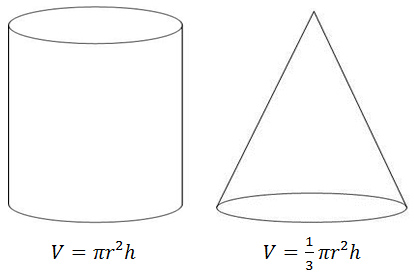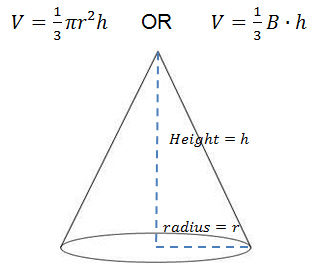 .
. .
. .
.The amount of space occupying a cone or volume is related to the volume of a cylinder. The base is a circle like the base of a cylinder, except different sizes of circles are put one on top of the other to find the volume.
How do the volumes compare if the area of both bases (B) and both the heights (h) are the same? This applet will illustrate the difference in the volume of a cylinder and cone with the same base and height. In the bottom left hand corner, select Cone -> Tank.
Refer to the applet to answer the following questions. Click on the blanks to reveal the answers.
 .
. .
. .
.Move the slider next to the cylinder to predict the height the liquid will be when poured from the cone into the cylinder.
Click on the Pour button to transfer the liquid from the cone to the cylinder.


Using the blue arrow next to the cylinder, slide the marker to the top of the liquid to see how the volume of the liquid from the cone compares to the volume of the cylinder. What did you discover?
Interactive popup. Assistance may be required.
The volume of the cone is about
1
3
the volume of the cylinder.

Click the New Problem button.
 .
.
The volume of a cone is 1 3 the volume of a cylinder.
Compare a cylinder and a cone by answering the following questions. Click on the blanks to reveal the answers.
 that is congruent to the bases. A cone has one circular
Interactive popup. Assistance may be required.
base
that is congruent to the bases. A cone has one circular
Interactive popup. Assistance may be required.
base
 at the bottom and the top or the opposite end is a point.
at the bottom and the top or the opposite end is a point. with an area of
Interactive popup. Assistance may be required.
A = πr2
with an area of
Interactive popup. Assistance may be required.
A = πr2
 .
. . The formula for the volume of a cone is
Interactive popup. Assistance may be required.
V =
1
3
πr2h or V =
1
3
Bh
. The formula for the volume of a cone is
Interactive popup. Assistance may be required.
V =
1
3
πr2h or V =
1
3
Bh
 . The only difference between the two formulas is the
Interactive popup. Assistance may be required.
1
3
. The only difference between the two formulas is the
Interactive popup. Assistance may be required.
1
3
 in the formula for the volume of a cone.
in the formula for the volume of a cone.
Since the circles are different sizes and have different areas the formula for a cone is:
